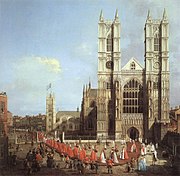
| Part of a series on the |
| History of the Church of England |
|---|
 |
The Church of England traces its history back to 597. That year, a group of missionaries sent by the pope and led by Augustine of Canterbury began the Christianisation of the Anglo-Saxons. Augustine became the first archbishop of Canterbury. Throughout the Middle Ages, the English Church was a part of the Catholic Church led by the pope in Rome. Over the years, the church won many legal privileges and amassed vast wealth and property. This was often a point of contention between Kings of England and the church.
During the 16th-century English Reformation, which began under Henry VIII (r. 1509–1547), papal authority was abolished in England and the king became Supreme Head of the Church of England. Henry dissolved the monasteries and confiscated their assets. The church was briefly reunited with Rome during the reign of Mary I (1553–1558) but separated once again under Elizabeth I (r. 1558–1603). The Elizabethan Religious Settlement established the Church of England as a conservative Protestant church. During this t .
The Settlement failed to end religious disputes. While most of the population gradually conformed to the established church, a minority of recusants remained loyal Roman Catholics. Within the Church of England, Puritans pressed to remove what they considered papist abuses from the church's liturgy and to replace bishops with a presbyterian system in which all ministers were equal. After Elizabeth's death, the Puritans were challenged by a high church, Arminian party that gained power during the reign of Charles I (1625–1649). The English Civil War and overthrow of the monarchy allowed the Puritans to pursue their reform agenda and the dismantling of the Elizabethan Settlement. After the Restoration in 1660, Puritans were forced out of the Church of England. Anglicans started defining their church as a via media or middle way between the religious extremes of Roman Catholicism and Protestantism; Arminianism and Calvinism; and high church and low church.
In the 1700s and 1800s, revival movements contributed to the rise of Evangelical Anglicanism. In the 19th century, the Oxford Movement gave rise to Anglo-Catholicism, a movement that emphasises the Church of England's Catholic heritage. As the British Empire grew, Anglican churches were established in other parts of the world. These churches consider the Church of England to be a mother church, and it maintains a leading role in the Anglican Communion.
For a general history of Christianity in England, see History of Christianity in Britain.
Cite error: There are <ref group=note> tags on this page, but the references will not show without a {{reflist|group=note}} template (see the help page).
© MMXXIII Rich X Search. We shall prevail. All rights reserved. Rich X Search
